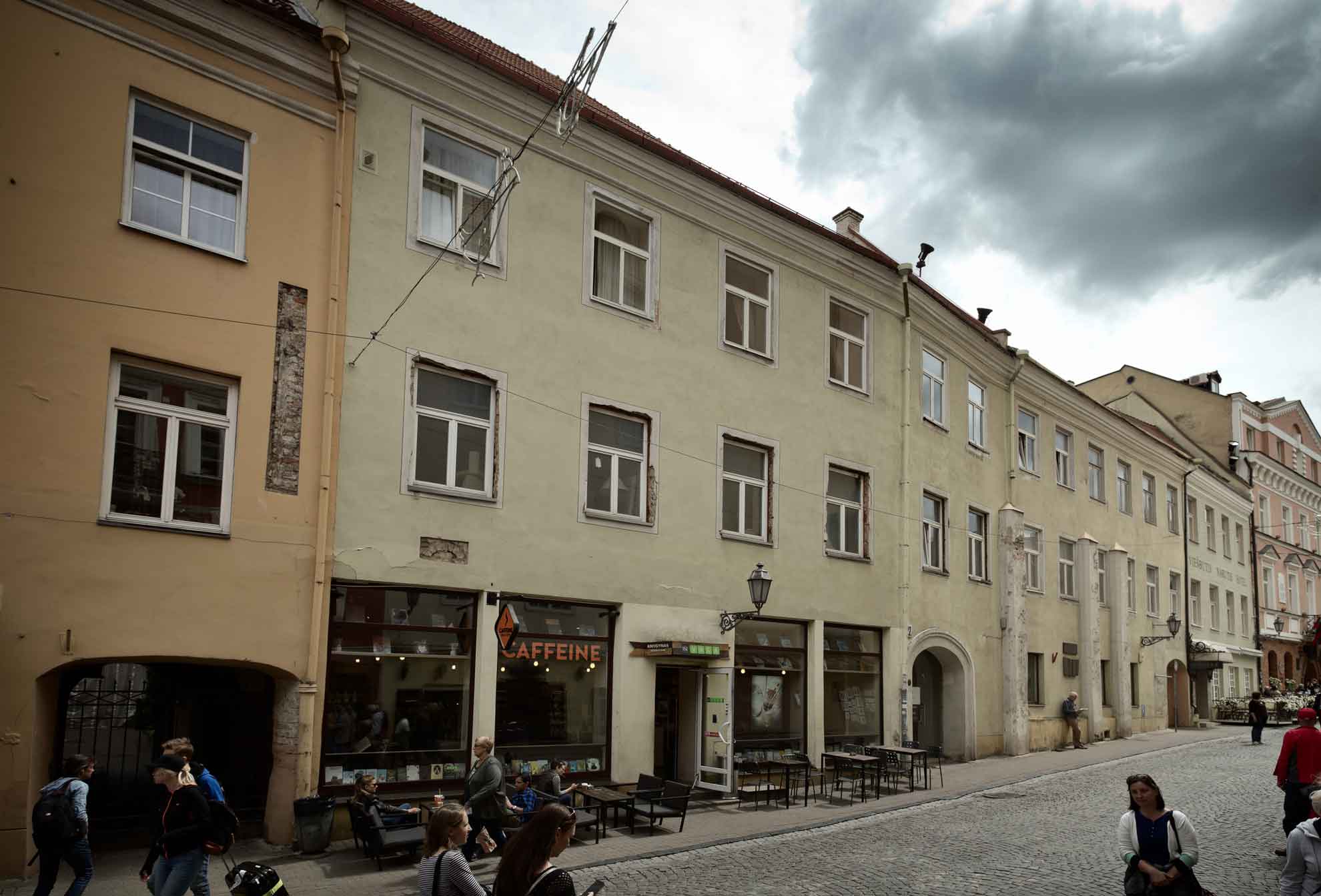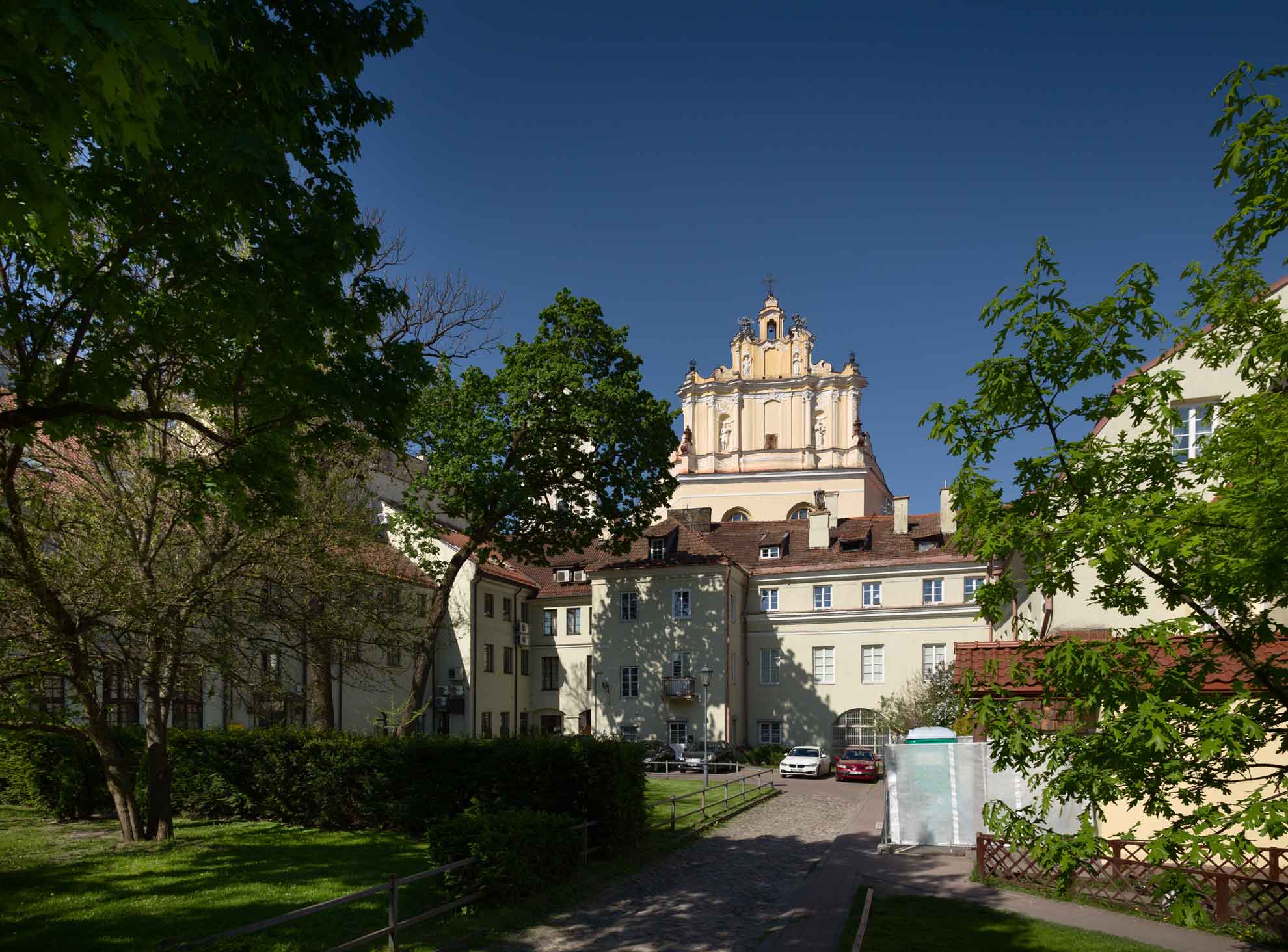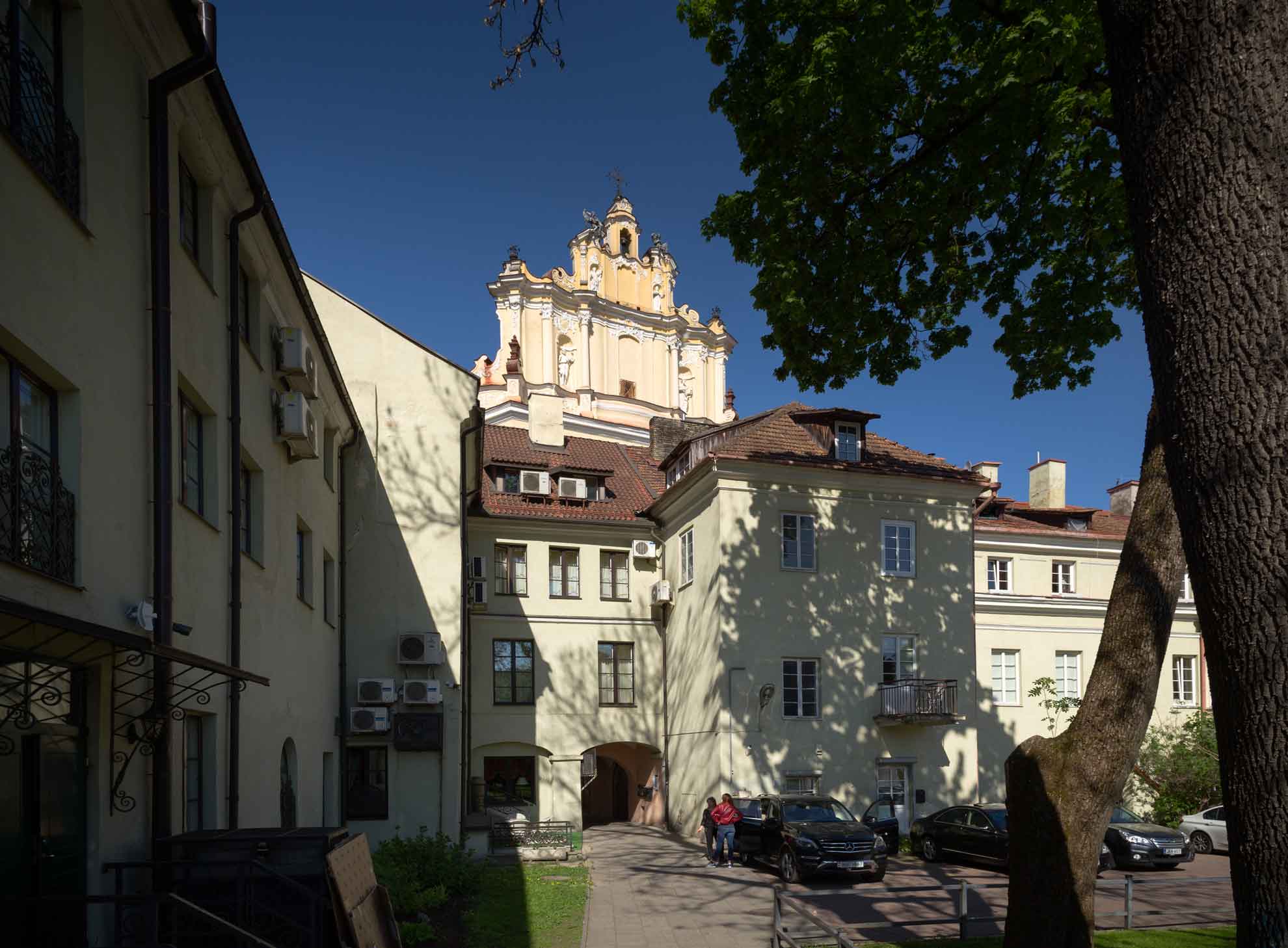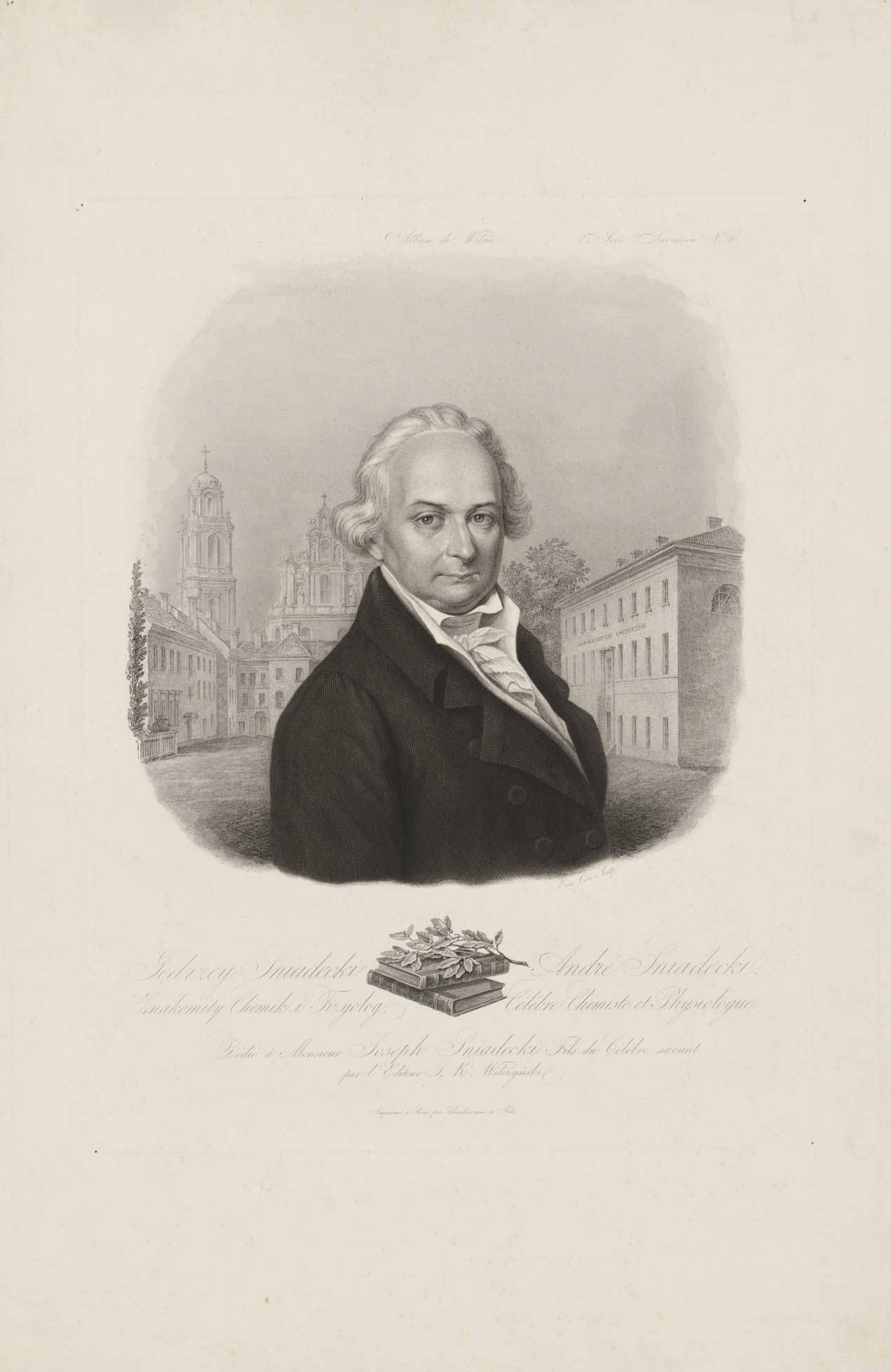22 Pilies Street

Photographer – Tomas Kapočius
22 Pilies Street. 2018
Lithuanian Art Museum

Photographer – Tomas Kapočius
22 Pilies Street courtyard. 2018
Lithuanian Art Museum

Photographer – Tomas Kapočius
22 Pilies Street courtyard. 2018
Lithuanian Art Museum
This building, which formerly belonged to Duke Michał Gliński, was given to one of the wealthiest Lithuanian magnates and one of its most famous war commanders Konstanty Ostrogski by the Grand Duke of Lithuania Sigismund the Old in 1508. The building and its spacious courtyard has attracted people of culture and science ever since the late 16th century. It is believed that this was where one of the first printing houses in Vilnius was located, founded by Daniel Łęczycki who printed books for the Reformed believers. In 1591 the house was rented by the first Lithuanian printer Jokūbas Morkūnas, who translated books into Lithuanian and printed Evangelical Reformed publications. The building’s owner in 1599–1601 was also a supporter of the Reformation, the printer Joannes Kartzan. During the war against Muscovy in 1655, the building was ravaged and left derelict for some time. A new stage in the building’s history began from 1683 and is related to the activities of the Vilnius Jesuit College and Academy. When the Jesuit Order was abolished and the college closed down, professors and students were accommodated in the building which was transferred to the university. The College of Medicine of Vilnius University was founded in the building complex in 1781, which was later reorganised to become the Academy of Medicine and Surgery, which functioned until 1842. The French botanist and medic Jean Emmanuel Gilibert established the Vilnius University Botanical Gardens and an orangerie in the college’s courtyard in 1782. His initiative was continued by the natural scientist and traveller Johan George Adam Forster, the first scientist to have started geological research in Lithuania, and Stanisław Bonifacy Jundziłł, who transferred the Botanical Gardens to Sereikiškės in 1799. The medical professors Stefano Lorenzo Bisio, Jacques Briôtet, Ludwig Heinrich Bojanus, Jędrzej Sniadecki and others lived and worked here. The poet Juliusz Słowacki lived and penned his first verses here in 1818–1828. Once the Academy of Medicine and Surgery was abolished, the office of the tsarist governor-general placed the buildings under its jurisdiction. By 1915 it had served as accommodation for the German army, as clothing, shoe, furniture and fruit stores, a hairdresser, beer-house and cafe. During the inter-war years, Vilnius University accommodated professors here – the philologists Jan Oko and Jan Otrębski, artist Ferdynand Ruszczyc and others resided in its premises. During the years of the Second World War, a book-store opened that exists to this day.
Individuals

Antoine Maurin (1793–1860)
Konstanty Ostrogski (~1463–1530). Mid-19 th century
Paper, colour lithograph
Lithuanian Art Museum

Jan Rustem (1762–1835), Marcelli Januszkiewicz (1806–1859)
August Ludwik Bécu (1771–1824). 1840–1858
Paper, lithograph
Lithuanian Art Museum
AUGUST LUDWIK BÉCU (1771–1824)
He was a medical specialist, Vilnius University professor, and a pioneer in vaccinations in Lithuania. He was originally from Hrodno and studied at Vilnius University, where he later taught pathology and hygiene. In 1803 he learnt about the existence of a vaccine against smallpox, and was the first to introduce its application in Lithuania. In 1805 he and his colleagues founded the Vilnius Medical Society. In 1808 he and Joseph Frank founded the Vaccination Institute which produced the smallpox vaccine and administered it to the public. He married Salomea Słowacka in 1818 and became a step-father to her son, the future poet Juliusz Słowacki. The family lived at 22 Pilies Street. Towards the end of summer in 1824, Bécu was struck by globe-lightning which flew in through an open second-storey window. People in Vilnius gossiped that this was punishment for allegedly informing on the Filaret Society to the tsarist government. Adam Mickiewicz presented an interpretation of this event in his poem Dziady (Forefathers’ Eve).
JACQUES BRIÔTET (1746–1819)
A physician and surgeon, and Vilnius University professor. He was born in France, studied medicine in Paris, and later worked in hospitals in Paris and Lyon. He arrived in Vilnius in 1777 after being invited to teach anatomy and surgery at the College of Medicine founded at the university (present-day 22 Pilies Street). He founded the anatomy cabinet at the university and prepared anatomical samples, which went on to form the foundation of the Vilnius University Anatomy Museum. In 1803–1810 he was head of the Department of Surgery at Vilnius University. Briôtet was one of the founders of the university surgery clinic. He lived on Pilies Street until 1819 (present-day 22 Pilies Street).
JEAN EMMANUEL GILIBERT (1741–1814)
He was a French medical practitioner and natural scientist. Completing his studies at the university in Montpellier, he worked as a doctor in Lyon and taught at the university there. In 1775 he arrived in Hrodno where he founded the first school of veterinary and medical science in the Grand Duchy of Lithuania, as well as a botanical garden. He taught the natural sciences at Vilnius University in 1781–1783 and was the first professor of the Department of Natural Sciences founded in 1781. He established the Vilnius Botanical Gardens on Pilies Street in 1782 (the courtyard at present-day 22 Pilies Street), where there were around 600 plant species. He provided the first herbal resource books, animal and bird taxidermal models and collections of excavated plant and animal remains to the university, as well as a mineral collection. He was the first to make a scientific description of the flora of Lithuania, for which he has earned the title of the father of botany in Lithuania. An attempt was made on the professor’s life in 1782: Gilibert’s relative wanted to lure away his wife, so he added poison to his coffee – the culprit was noticed by Gilibert’s student, Anupras Orlauskas. The scientist was saved, and special medal to commemorate the student’s heroism was made. In 1783 Gilibert returned to France where he briefly served as the major of the city of Lyon during the revolution.
JOHAN GEORG ADAM FORSTER (1754–1794)
He was a traveller, natural scientist and writer. In 1772–1775 he participated in James Cook’s second journey around the world. Forster taught mineralogy, botany, zoology and palaeontology at Vilnius University from 1784. He studied the country’s plant life and maintained the university’s Botanical Gardens (the courtyard of present-day 22 Pilies Street). A plot of land was purchased in Sereikiškės in 1787 as the courtyard in the College of Medicine was too small for the Botanical Gardens. He left to work in Germany in 1787, where he became one of the brightest figures in the German Age of Enlightenment, renowned for his progressive attitudes. He wrote books and is considered one of the pioneers of modern travel literature.

Erin Corr (1805–1862), Jan Kazimierz Wilczyński (1806–1885)
Vilnius University professor Jędrzej Śniadecki (1768–1838). 1848
Paper, steel engraving
Lithuanian Art Museum
JĘDRZEJ SNIADECKI (1768–1838)
He was a chemist and physician. He studied medicine and chemistry at the universities in Krakow and Padua, and furthered his studies in Edinburgh, London and Vienna. From 1797 he lived and worked at Vilnius University (at present-day 22 Pilies Street), heading the Department of Chemistry and establishing a chemistry laboratory. Following the university’s closure, he taught at the Academy of Medicine and Surgery in 1832, serving as a professor at the Department of Therapy and head of the internal diseases clinic. He was also the vice-president of the Academy of Medicine and Surgery and one of the founders of the Vilnius Medical Society (1805), where he was the first chairman. In 1817 he started the Society of Szubrawcy (Rascals). He laid the foundations for chemical terminology in Polish and wrote the first chemistry textbook in Lithuania Początki chemiji (Basic Chemistry, 1800). His study Teorya jestestv organicznych (Theory of Organic Beings, 1804–1811) is considered one of the first textbooks of theoretical biology and biochemistry in the world. He published scientific papers on biology, chemistry, medicine, geology, mineralogy and other topics. He also analysed dietary issues, diagnostics and treatment, promoted hygiene, and was a pioneer in pediatrics in Lithuania.
JULIUSZ SŁOWACKI (1809–1849)
He was a Polish poet and playwright. Born in Kremenec (present-day Ukraine), he and his family moved to Vilnius in 1811–1814 and lived in a building belonging to the university (his father Euzebiusz Słowacki was a professor in Polish literature at Vilnius University). After his father’s death in 1814, the mother and son returned to Kremenec. In 1818 his mother married the Vilnius University professor August Bécu, and the family settled in the College of Medicine building (present-day 22 Pilies Street). Whilst living there, the young poet wrote his first verses. He studied law at the university in 1825–1828. From 1828 he lived in Warsaw, and emigrated after the uprising of 1830–1831 was crushed. He died in Paris in 1848 from tuberculosis. He had written sonnets, poems, dramas and tragedies, and was considered one of the greatest Polish Romantic poets. A memorial plaque and bust was unveiled in 1927, initiated by the artist Ferdynand Ruszczyc (sculptor Bolesław Bałzukiewicz).
FERDYNAND RUSZCZYC (1870–1936)
He was a Lithuanian painter, graphic artist, stage designer and pedagogue. He completed painting studies at the Academy of Art in Saint Petersburg. He taught at the Warsaw Art School (Mikalojus Konstantinas Čiurlionis was one of his students) and at the Krakow Art Academy. He lived in Vilnius from 1908, and had settled down on Pilies Street (present-day 22 Pilies Street) in 1923–1934. He was an active participant in the city’s cultural life, organising events, dramatisations, stage sets and theatre costumes. He worked intensively in the field of published graphic art, illustrating magazines and books. He was also interested in preserving the cultural heritage of Vilnius. He was active in the reinstatement of Stephen Bathory University in 1919, becoming the dean of the Faculty of Arts where he taught until 1932.

